Chestnut Orcharding
CHESTNUT ORCHARDING
The U.S. is the only country in the world that can grow chestnuts and does not have a large commercial chestnut industry. The U.S. imports $20 million of chestnuts yearly because there are fewer than 2,500 acres of chestnut orchards in the U.S. It would take 10,000 acres of producing chestnut orchards to supply what we import.
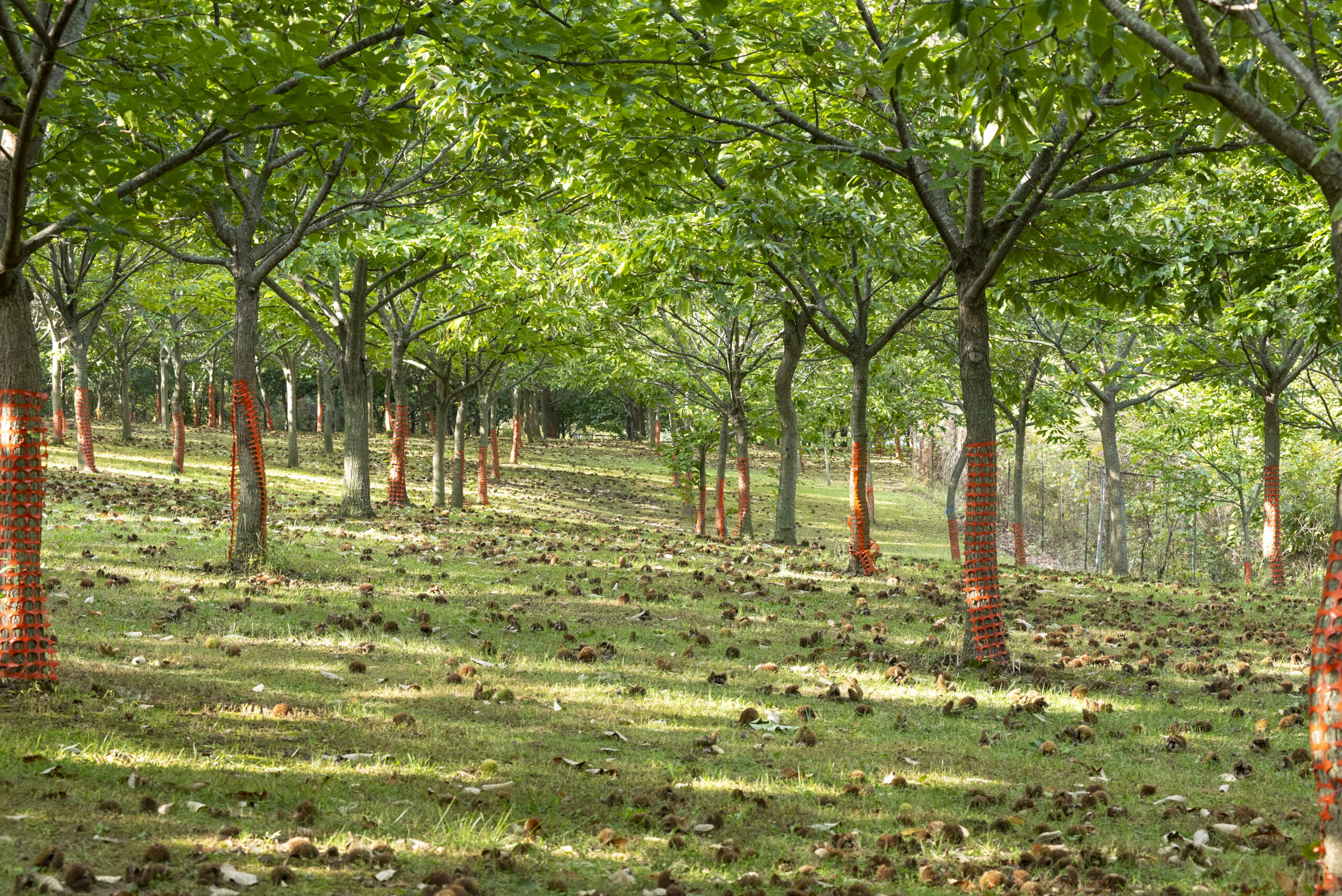
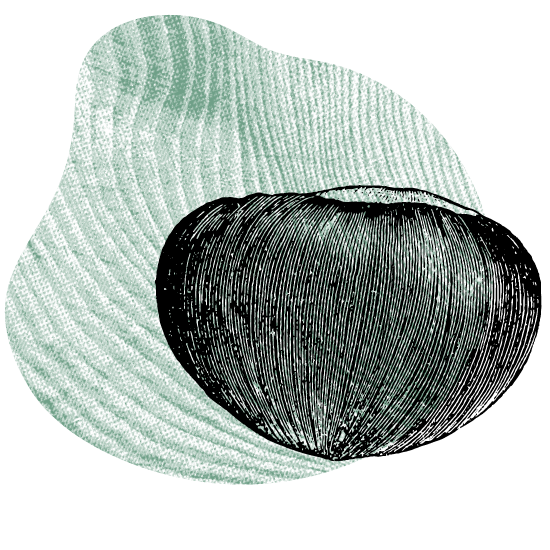
LARGE MARKET POTENTIAL
American-grown nuts can reach the market sooner, fresher, and bring a higher price than imports, which are often low in quality, often because grocers do not know how to handle them and the nuts spoil at room temperatures. U.S. consumption is less than one ounce per person per year, but one pound per capita in Europe and 2 pounds in Asia. It would take 120,000 acres of chestnut orchards to supply U.S. consumption at European levels and create a $300 million new agricultural industry for America. Growers who produce high-quality chestnuts in America will have a virtually unlimited market available to them for many years to come.
VERY PROFITABLE ORCHARD CROP
Chestnuts can be a very profitable crop. They begin to bear in only 3-5 years, and by 10 years can produce as much as 10-20 lbs/tree. At maturity (15-20 years) they can produce as much as 50-100 lbs/tree or up to 2,000-3,000 lbs/acre each year. (Trees planted in colder regions such as USDA zone 5, may bear between 5 and 7 years of age.) Wholesale prices for large, high-quality chestnuts are $3.00-5.00/lb, and higher for organically grown chestnuts. Retail prices range from $3-10.00/lb. This is a superior return to pecans, hazelnuts, and many other tree crops!
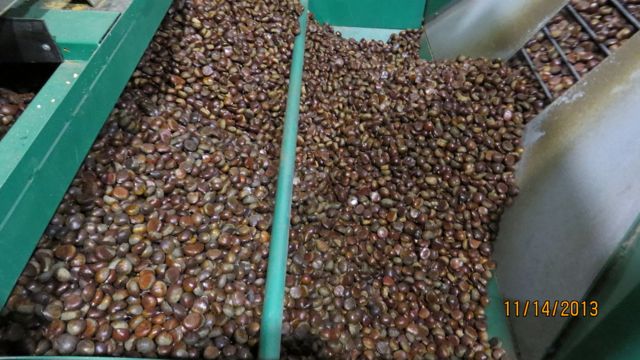
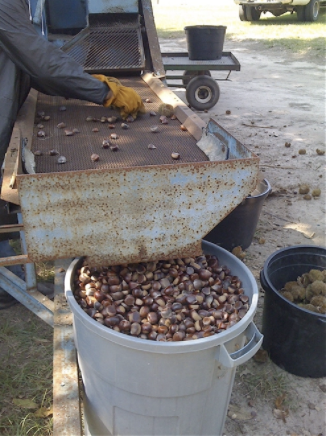
One of our orchardists grows his crop organically and harvests 16,000 lbs on 10 acres, selling them to Whole Foods for $6.00/lb on average. That is a nice return for a small orchard and seasonal work to harvest and ship!
HOW TO ORCHARD CHESTNUTS
The following guidelines will help you understand all of the processes of setting up and operating a commercial chestnut orchard. REMEMBER THAT THIS IS FARMING! There are no guarantees, and you will get out of the orchard what you put into it. The following information will give you guidelines to choose the right location, establish your trees, and take your crop to market.
SITE SELECTION
If you want to grow chestnuts commercially, it is better to look for the right piece of land than try to force the trees to grow in a poor location. If your land does not fit the descriptions below, you will face problems with tree growth and production.
Pick a location with good soil drainage and good air drainage such as on the top or side of a hill, to avoid frost pockets where cold air or late frosts settle at the bottoms of valleys. Avoid areas with soil that stays saturated for long periods of time, such as creek bottoms or low areas that stay saturated during snowmelt in spring. Areas that are too steep may be hard to harvest with machinery.
SOILS
Chestnuts prefer a well-drained (better drained than apple trees require) sandy loam with a pH of 5-6.5 but will grow in other soils. Avoid heavy clay and wet soils with a high water table or that stay saturated for long periods of time.
Look at the trees on the surrounding property. If the land supports large oak and hickory trees naturally, it should be good for chestnuts. If the native vegetation is poor (unless the land was recently logged), look elsewhere.
For more information visit the Soils page in the Learning Center.
PLANTING BASICS
Follow our planting instructions for initial planting. For additional growing information continue to the Growing and Care section of the Learning Center.
IRRIGATION
Irrigation is insurance. If you do not have irrigation, you cannot expect to get good growth of the trees as quickly or consistent crops of nuts. Water is the limiting factor for most tree growth, and if the year you plant is a drought year, your trees will struggle and may not live without adequate irrigation. If they are stressed at the beginning, they may never fully recover and grow into strong healthy trees. Irrigation eliminates many (but not all) of these risks. It is inexpensive and easy to install, and readily available at Irrigation Supply stores such as John Deere Landscape stores. We strongly recommend using an irrigation system in your orchard.
GROW TUBES
Grow Tubes offer many benefits in the growth and establishment of young trees. Read more about Grow Tubes here. We recommend their use as an important part of establishing and protecting your orchard.
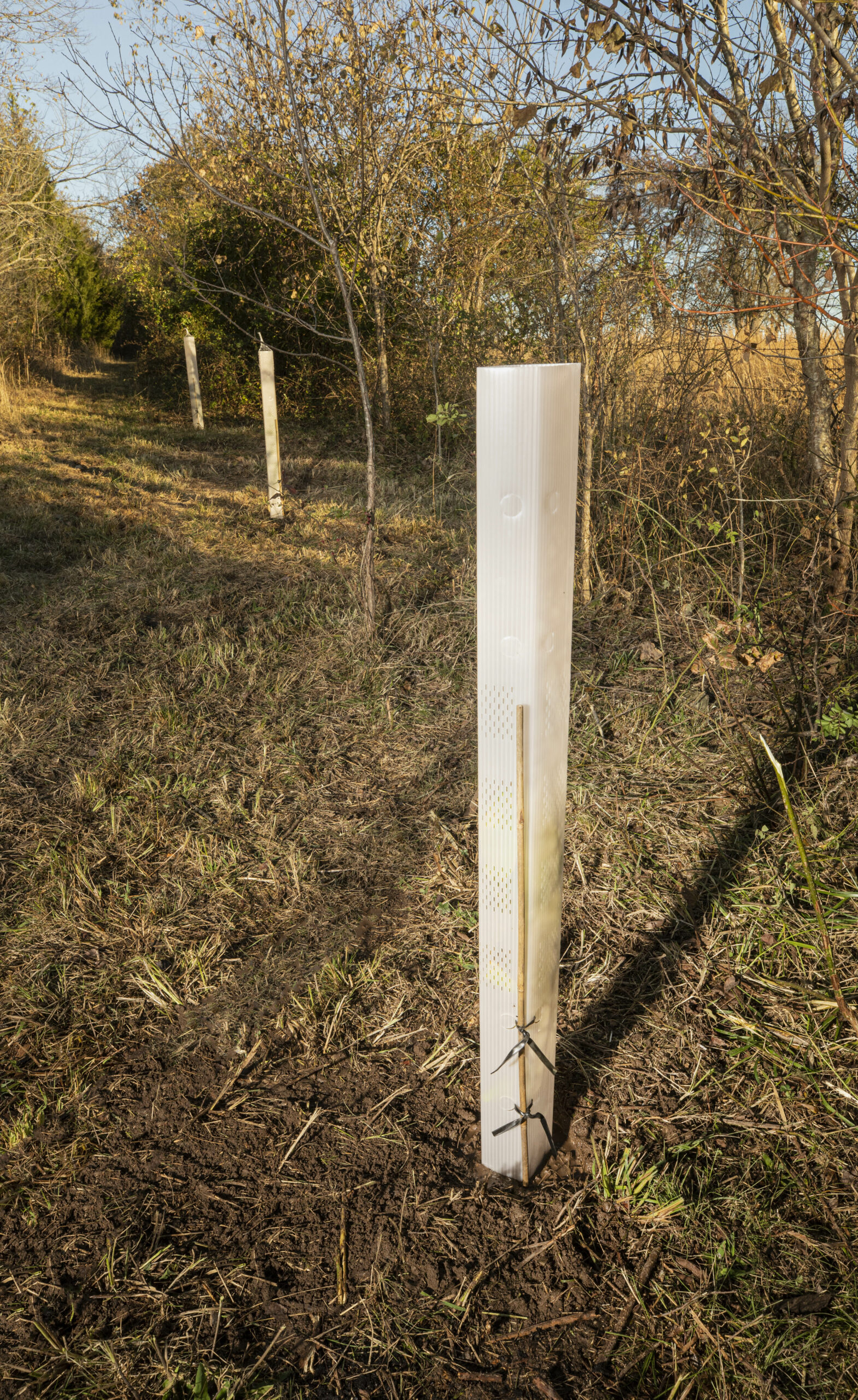
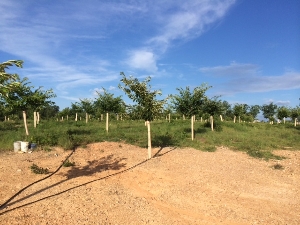
PROTECTING YOUR ORCHARD
Animals, especially deer, love to eat chestnut nuts and leaves and rub the velvet off their antlers on young trees. Grow tubes help protect against deer browsing and killing the young trees with their antlers, as well as protect against rodents and rabbits chewing on the trunks, especially during winter when food is scarce. However, if nut predation is severe, it may be necessary to fence your orchard. An 8’ metal deer fence is expensive, especially on large orchards. A very effective alternative is a 3 wire electric fence. Deer can eat up to half of all production in an orchard so it is important to look into protection.
FERTILIZATION
It is essential to provide sufficient fertilizer to push trees into growing as rapidly as possible and to make up for deficiencies in soil fertility on your land. Do not use standard agricultural fertilizer at planting as it may burn the young roots. We recommend time-release Scotts Osmocote or a similar fertilizer with a broad spectrum of micro-nutrients. Once the trees are established your local County Agent can analyze soil tests and determine the best fertilizer regime for continued growth.
WEED CONTROL
Grass and weeds are the biggest competitor for water and nutrients with a young tree trying to get established. Weed control is essential to orchard establishment. We recommend weed mats, and the careful use of herbicides such as Roundup (Glyphosate). Roundup can kill young trees even through the bark, so you must protect the trees with Grow Tubes or a shield during application.
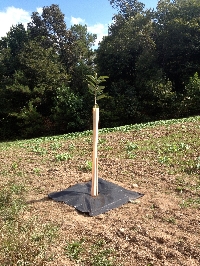
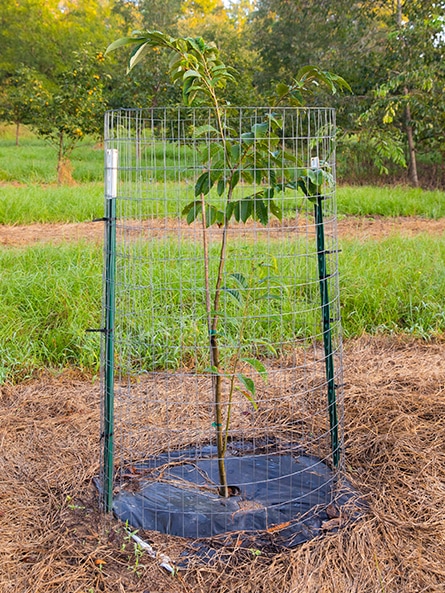
ORGANIC GROWING
Organic chestnuts can bring as much as 50% higher prices than non-organic, in part because all imported nuts into the U.S. must be fumigated during importation, so no imported nuts can be labeled organic. Specialty health food grocers are very interested in purchasing American-grown organic chestnuts.
However, growing organically is not easy. It is difficult to provide enough nutrients, especially Nitrogen, organically. It requires much more work and expense. There are some good alternative sources of organic fertilizers such as Fertrell and worm casting tea, but fish emulsion, bone meal, blood meal, kelp products, and other sources may not provide sufficient nutrients and the growth of the trees may suffer.
The other problem is if your orchard is infested with Chestnut Weevil. At present, there is no organic spray to combat this. Many areas in the east have weevils, especially if there are old Chinese chestnut trees growing in the area (common in Appalachia).
If you are interested in organic growing, we recommend using traditional chemical fertilizers in the first 3-5 years to push your trees and grow them as large as possible, and then transition to organic production (3 years chemical-free is required to be Certified Organic) as the trees begin to bear.
It will require additional research to learn the best ways to grow your trees organically and may be possible if you are in a pest-free area.
TREE SPACING
Dunstan Chestnuts can get large, as much as 60’ tall and 40’ wide. We recommend a 30’x30’ (54 trees per acre) or 40’x40’ (25 trees per acre) spacing for planting. Chestnuts bear on the outer growth each year, and so maximizing sunlight around the tree increases overall production. If the trees are planted closer (20’x20’), it will increase early nut production but the trees will crowd out and production will only occur at the top of the trees (15+ years). The orchard will need to be thinned, or trees will need to be radically pruned to keep them on this spacing.
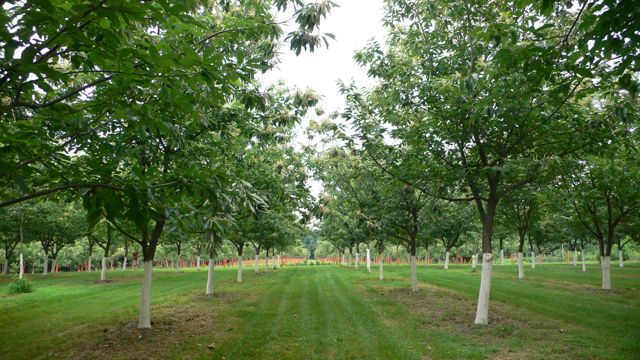

GRAFTED VS SEEDLING TREES
Most orchard crops are planted with grafted (cloned) trees of particular varieties. However, chestnuts, due to several reasons, do not graft well, and in particular, grafted trees suffer high mortality rates in the first few years after planting. This is due to latent graft incompatibility between rootstock and scion and is more severe in northern states (sometimes as much as 50-90% loss) than in less stressful environments. Because of this we no longer sell grafted trees. Grafting may work when young seedling rootstock is established in the field and then grafted in place after 1-2 years. However, for best results, the seedlings must be grown from nuts harvested from the particular varieties that you want to use to graft (and even this does not always stop incompatibility).
Our Dunstan Chestnut trees are grown from seed harvested from an orchard of grafted trees of our largest nutted varieties all inter-pollinating each other, and we plant only the largest nuts. Chestnuts are affected by metazenia, in which the nut size of the male pollen parent determines the nut size of the tree grown from nuts planted from these trees.
Over 35 years we have learned that our Dunstan trees bear consistently good-sized nuts, averaging 20-35/lb, which brings the highest prices in the market. This has been proven by many of our growers who planted these same trees. We believe it is better to have trees bearing large but sometimes variable nut sizes than to have dead trees in the orchard from graft incompatibility.
ORCHARD FLOOR
It is important to have a grass cover in the orchard under the trees that can be mowed close to allow for easy harvest. Finish mowers or flail mowers are used that mow closer than Bush-hog style rotary mowers, and grass species should be chosen that have low growing profiles. Your local County Agent can make recommendations of different types available for your region.
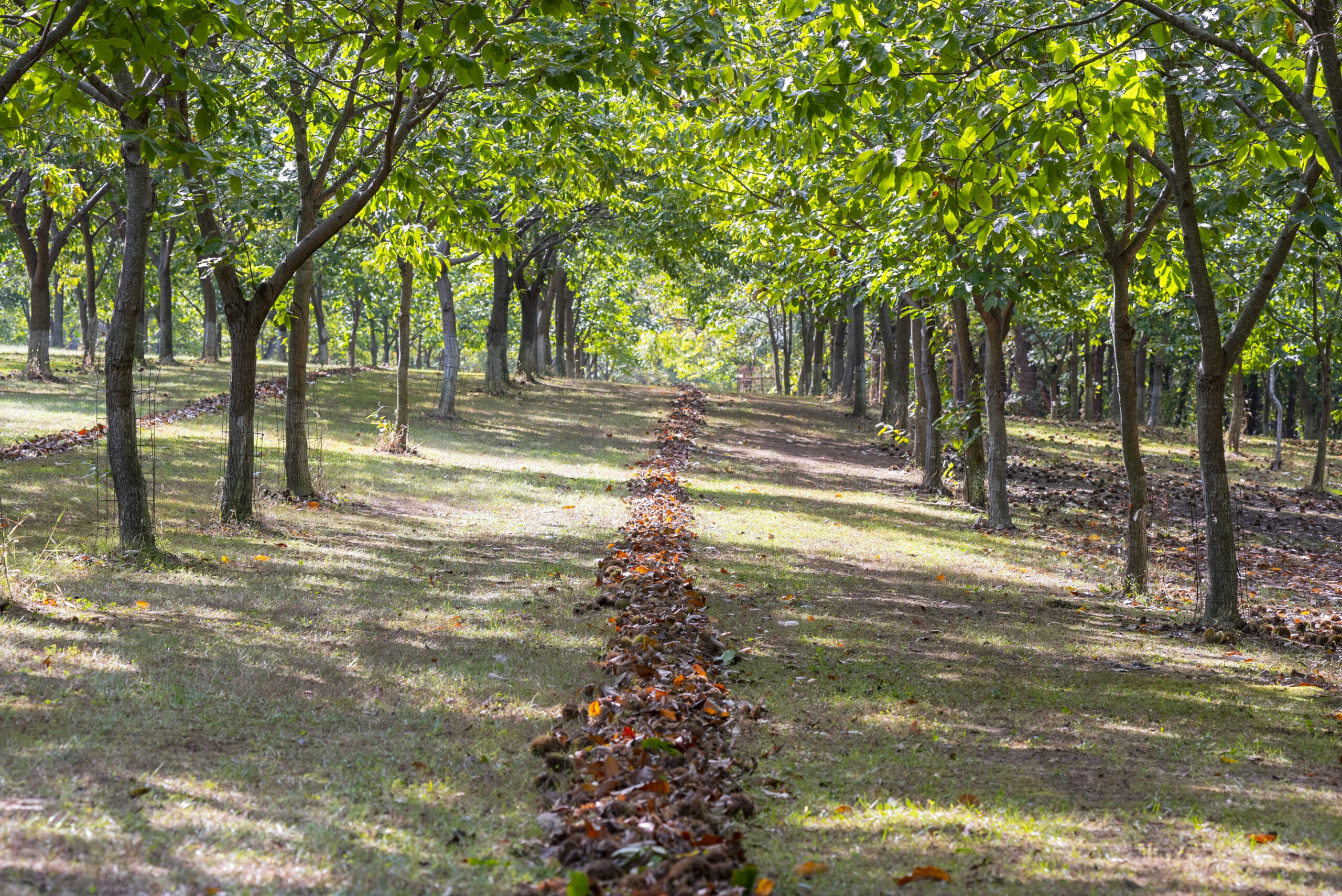
Strips along the rows of trees on both sides can be kept clean with herbicides such as Roundup and pre-emergent herbicides to keep weed seed from sprouting, or the areas under the trees can be covered with nursery ground cloth (weed mats) for organic production.
If the area you are planting was not in field agriculture before (that has been plowed regularly and is relatively smooth), you will need to remove stumps and level the surface by plowing first as much as possible so that when the grass is established it will be on a smooth surface that can be mowed for harvest.
PRUNING
Chestnuts are grown in a central leader form, with the main trunk growing straight and branching beginning high enough off the ground to be able to mow and allow machinery access underneath (6’+). Getting hit by a low-hanging branch with a chestnut burr while mowing is not pleasant! The trees grow in the pattern somewhat naturally, but some limited pruning to remove branches that get crossed or hang down may be necessary. Do not over prune – they are not like peaches that require annual heaving pruning.
HARVEST
Chestnuts ripen beginning in early September in the deep South, in mid-September in the central states and in October in northern states. The harvest lasts 4-6 weeks depending on varieties and climate. Most of the growth in the size of the nuts occurs in the last month before harvest, so if conditions are not optimum (enough moisture or an early freeze) the crop can be affected.
Chestnuts are borne in spiny husks called burrs. These burrs open naturally when the nuts ripen and both nuts and burrs fall to the ground.
Traditional harvest is done by hand. We call this a U-Prick operation! Heavy gloves are a necessity. Pickers can be paid by the pound or by the bucket to incentivize them to work quickly and control costs. Some growers offer this as a fund-raiser to schools or church groups, etc.
In warmer climates, nuts should be harvested daily if possible to lower the desiccation and spoilage of the nuts in the field. In northern areas nuts can be harvested less frequently, however without fencing, predation by deer and other animals can dramatically lower harvest quantities.
Nuts and burrs are brought into the barn and separated by hand or by using a machine called a Pecan Cleaner (see photo). This has a rotating drum that rubs the burrs off the nuts and separates them.
Commercial nut harvesting machinery used in California for almonds and walnuts will work on chestnuts, but the orchard floor must be smooth and flat for this to be effective. The nuts are swept into a windrow between the orchard rows, picked up with a machine, and deposited into bins for hauling to the barn.
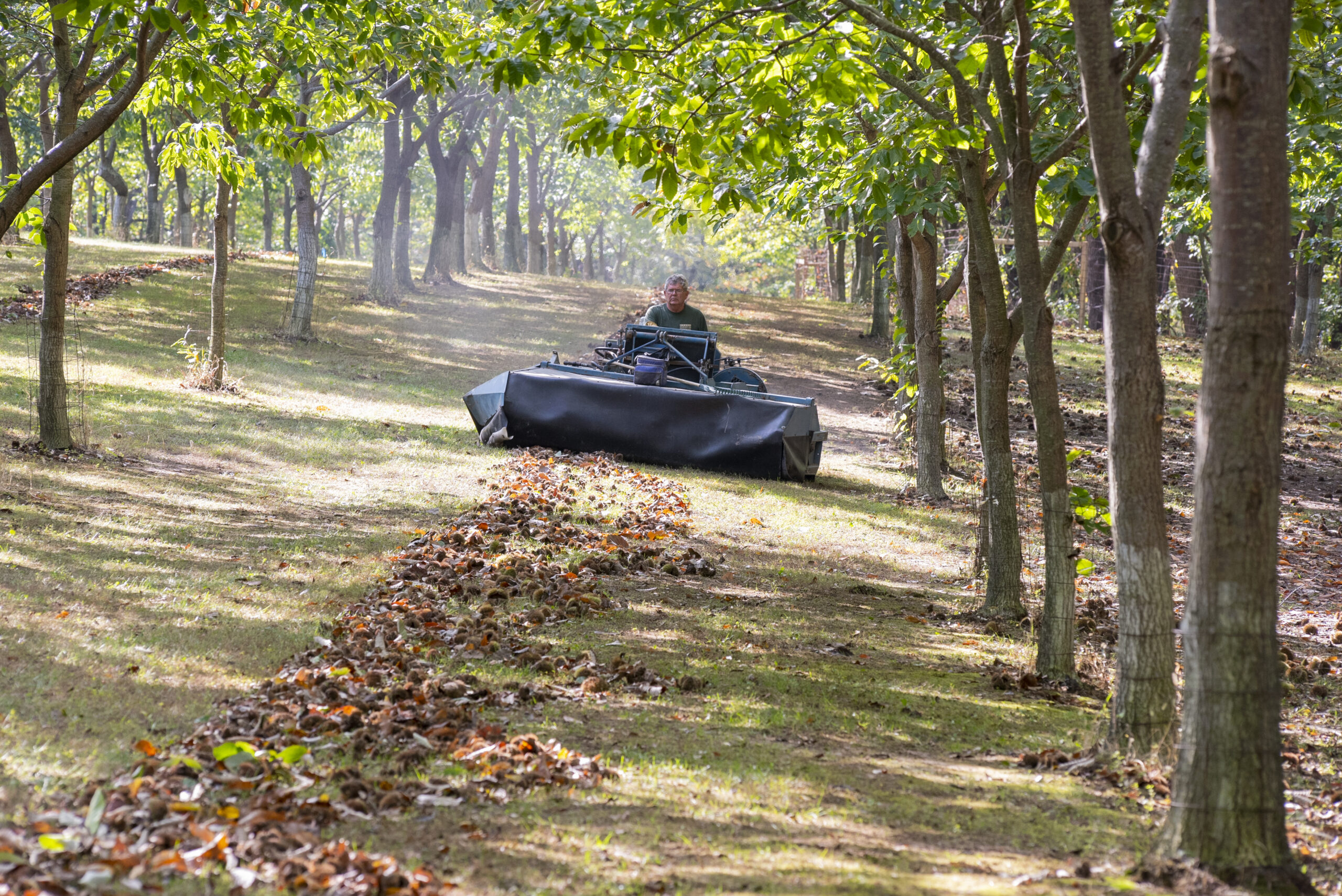
Alternatively, suction harvesters are made in Italy by FACMA and work like giant vacuum cleaners are available that sucks the nuts and burrs off the ground separates the nuts from the burrs, and puts the nuts into bags. These machines run off the tractor PTO and can pick up as many nuts per hour as 10 workers with only 2-3 people to run it.
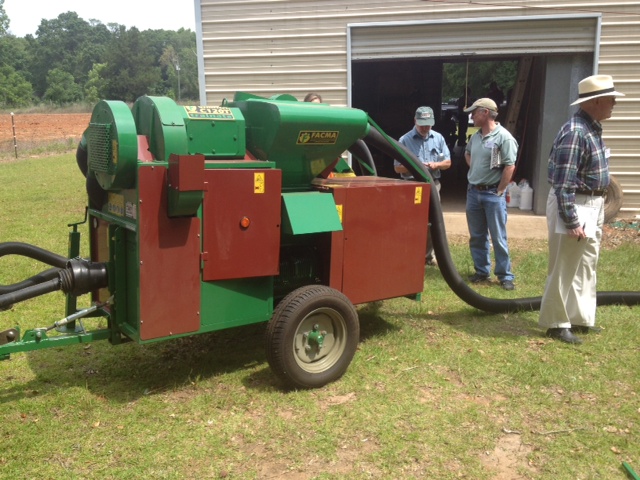
POST HARVEST and STORAGE
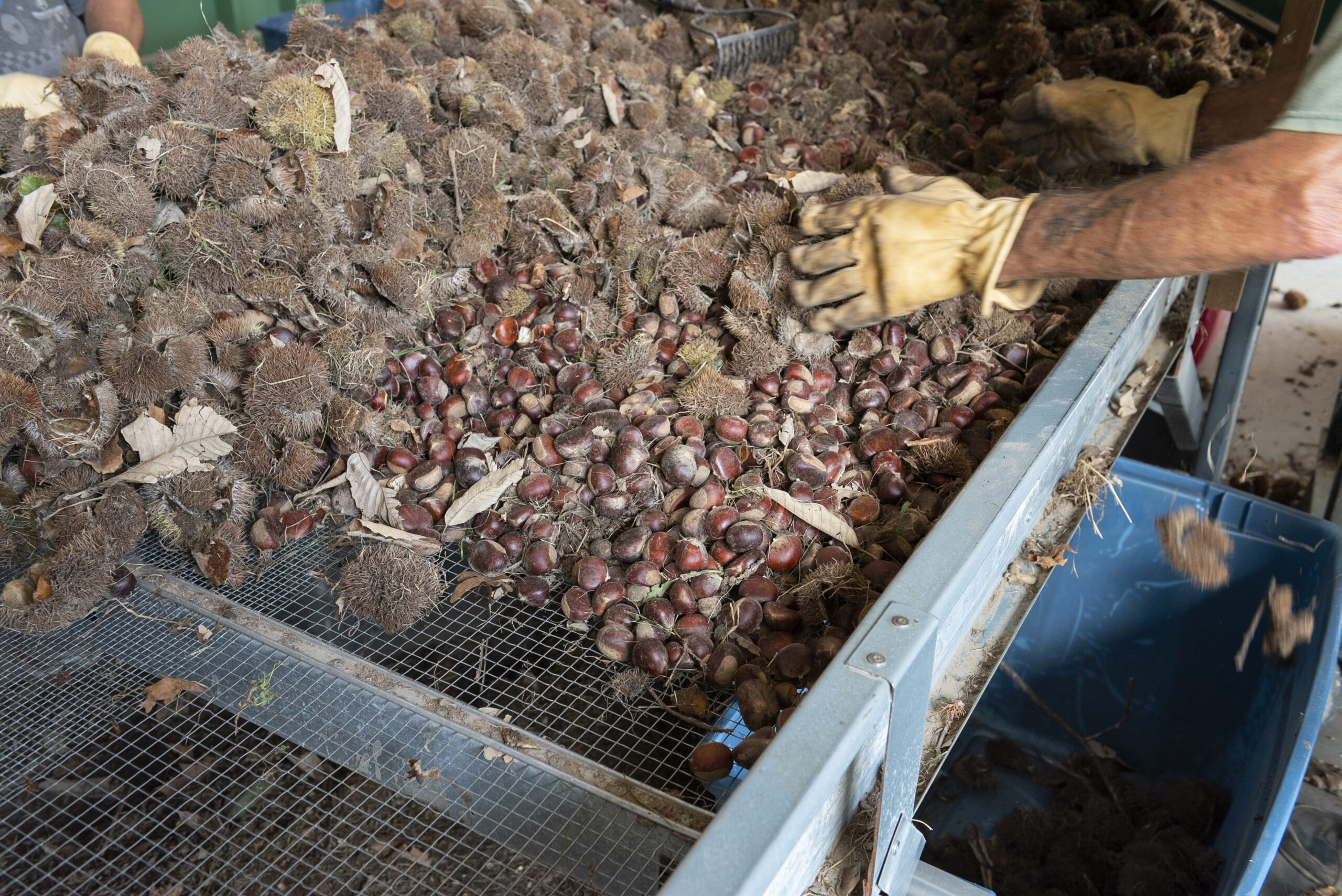
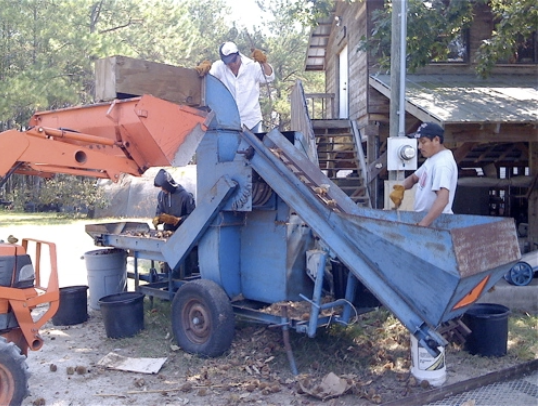
Once the nuts have been removed from their burrs. They are washed in a water bath. If you have a weevil infection, the nuts must be soaked in hot water (122F) for 30 minutes and immediately cooled to 32-35F in a cooler. This kills weevil eggs before they hatch. Nuts with worms (young weevils) float to the surface and are removed and destroyed.
After washing, nuts are run on a sorting line for inspection and then through a sizer. The sizer is a rolling drum with different-sized holes, allowing the nuts to fall through to bins below (see photos below). Nuts are sized by diameter and # of nuts per pound.
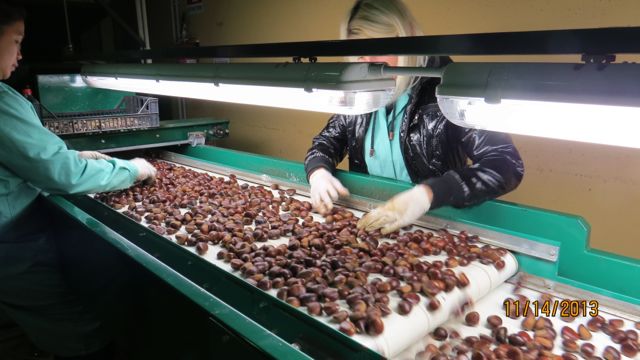
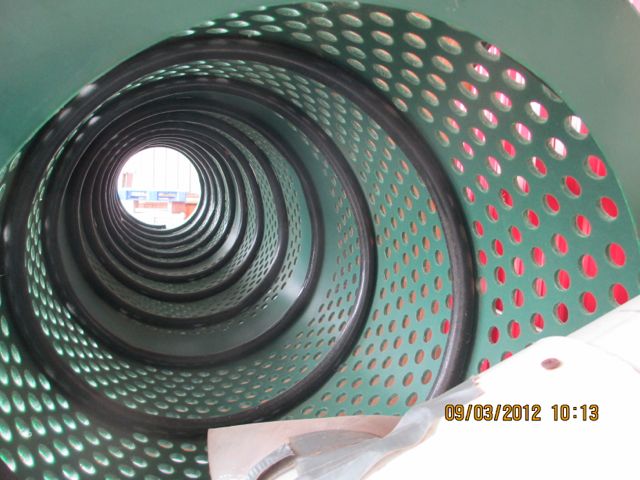
Once sized, nuts are placed in a woven breathable polyethylene bag (the type used for rice), typically in 26-pound increments, to allow for desiccation and net 25 lbs/bag.
Because chestnuts are living seeds, if they dry out the embryo dies and the high levels of carbohydrates allow mold to infect the nuts. The nuts must be stored under refrigeration as soon after harvest as possible. Traditionally in Europe, they were stored in caves, or under chestnut leaves on the north side of a building in the shade.
Store the nuts at 32-33F in a walk-in cooler. These may be purchased from restaurant supply houses (those specializing in used equipment) or a reefer shipping container can be outfitted with an electric cooling unit (instead of the diesel).
The cooler should be sterilized with Zeritol or other cleaner and kept clean. The bags of nuts should be rotated regularly as this decreases the spread of mold between nuts and bags. Nuts stored this way should last 2-3 months through the selling season.
SELLING YOUR CROP
The market for chestnuts is virtually unlimited. American nuts get to market earlier, fresher, and in better condition than imported nuts and can bring a higher price. The present growers that have established markets do not have nearly enough chestnuts in supply to meet the demand for their crop.
However, you will have to work to make the connections to sell your crop. If you have never sold anything before (except maybe a car or a house), it can seem daunting to walk into a grocery store and try to pitch the produce buyer to purchase your crop. The following is a list of different buyers of chestnuts in the market today.
Remember that the cost of freight (delivery to the customer) is a key component of the final price to the buyer and must be factored in when quoting prices.
Cooperatives
There are several regional Cooperatives in Florida, Ohio, and Michigan that already have markets for their crops, and you can join a co-op and sell through them. The co-ops typically deduct a fee for handling and storage and may have cleaning lines and storage facilities available, lessening the initial investment. The folks that run the co-ops are also excellent sources of information on how to grow and sell, facing the same problems as you.
Grocery stores and chains
Many grocery stores and even chains are promoting buying local produce. Ask the produce department manager if they have the ability to buy from local growers. This can work quite effectively for selling your crop. However, some larger chains need sources that can supply many stores over the holiday period from before Thanksgiving through Christmas, and there are no orchards or co-ops in the U.S. today that have this capacity – they can only provide enough for a few stores in a limited area. The natural food chains such as Whole Foods Market, Earthfare, Fresh Market, and even Safeway all support local sourcing and will pay a premium for organically grown nuts.
Remember that to be set up as a vendor to some grocery chains will require a large liability insurance policy (as much as $2 Million) with the chain listed as additional insured, plus may have a lengthy Vendor setup process, require UPC bar-coding, etc.
Food Brokers and Distributors
Food brokers work between the suppliers and the grocery chains. They are also the major importers of chestnuts into the U.S. They will charge a 6-10% fee for handling the sale, depending on volume. They know the markets that buy the nuts and may be a valuable outlet.
Distributors purchase the product and hold it in storage to resell to their customers, both grocery chains and restaurants. This can be a valuable avenue to move your crop. Distributors that specialize in fresh produce are the best target to sell to.
Asian Food Stores
Asians and especially Koreans still consume large quantities of chestnuts as part of their cuisine and are avid buyers of chestnuts. Every major metropolitan area has an extensive network of Asian food stores and distributors. They will bargain to pay as low a price as possible. Some prefer smaller nuts, considering them sweeter and more flavorful. By contacting stores near you, you can learn who the buyers are.
Restaurants
Buy local is a major trend for many upscale restaurants. These can be excellent markets, and also eliminate the middleman in the sales process. Develop relationships with area chefs that specialize in this cuisine. This is also a great way to gain publicity for your farm. The chefs will have time slots in their schedules for reviewing new foods. They are approached by many vendors so set up an appointment and give them samples to try and suggestions for how to prepare them.
Farmers Markets
Roasting chestnuts to taste and for sale at farmers’ markets is an excellent way to sell your crop and educate consumers on how to use chestnuts, as well as promote your farm. You also get retail instead of wholesale dollars and this can provide more income, especially in the early stages of orchard development.
Internet direct to consumer
This process brings the highest dollar return per pound, but also entails a substantial amount of time, answering emails, processing orders, and shipping individual orders by UPS or USPS. You will need to set up a Merchant Services account with your bank for accepting credit cards online using a shopping cart. There are a number of smaller orchards selling this way currently in America, and prices vary.
One of the key issues with selling online is getting found among all of the other competing sites, through design to enhance Search Engine Optimization (SEO) or paid searches such as Google Adwords.
Value-added products
Some growers have had excellent results with selling nuts or dried nuts to breweries that make chestnut beer (links), and for manufacturing into other products.
In Europe, chestnuts are dried and ground into flour, which is used in a variety of cakes, pastries, pasta, and desserts. Chestnuts are also ground into a puree and sweetened with cane sugar and other flavorings, resulting in delicious jams and preserves.
MARKETING
There is no organized marketing of chestnuts in America. This is a major need for the industry and will increase the consumption and sales of chestnuts.
The Chestnut Growers of America (www.chestnutgrowers.org) is the only growers association devoted to chestnuts. The CGA publishes a newsletter and holds annual meetings in different parts of the country where growers can meet and learn from each other.
The following is a list of different marketing techniques to help you sell your crop:
Website
This is clearly the first step in the process, to give customers information on where and how to buy. There are many inexpensive website design and hosting solutions available today, depending on the complexity of whether or not your site is informational only or you intend to sell directly from the site. It is important to update your website regularly. Search engines pick up on new information, and having a news section on the home page helps inform customers what is going on.
Email and Facebook
Email is a very effective tool for selling and you should build an email list at every opportunity, such as when meeting people at Farmers Markets, etc. You can also build target lists of customers such as local produce buyers, restaurants, etc. Make sure you have a “join our mailing list” link on your site.
Facebook can be an effective tool but requires effort to post updates and build a “Like” network.
Newspaper and local magazine articles
Local columnists look for new ideas all of the time, and chestnuts are a perfect seasonal topic. Feed them information such as a fact sheet, website address, how to buy, etc.
Farm events
Having a fall farm tour, during or after harvest, is an excellent way to spread knowledge about your products, and is easy to promote through local newspapers, etc. Your County Extension Agent will have a valuable network and mailing list to promote farm tours. Make sure your website is always mentioned.
POP Fliers
Point of purchase fliers on how to handle chestnuts at both the store level and at home, and recipes are an effective way to educate consumers.
National marketing
One of the goals of CGA is to establish a national marketing program. Point-of-sale fliers and recipe cards are simple and universally useful. National advertising is very expensive, and there is not sufficient nut supply at this current time to afford a national campaign.


